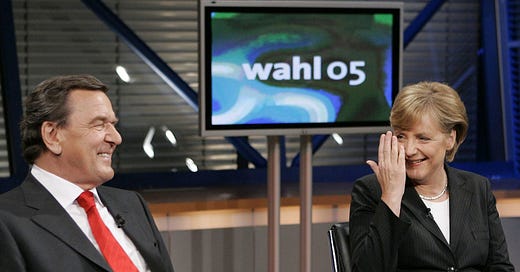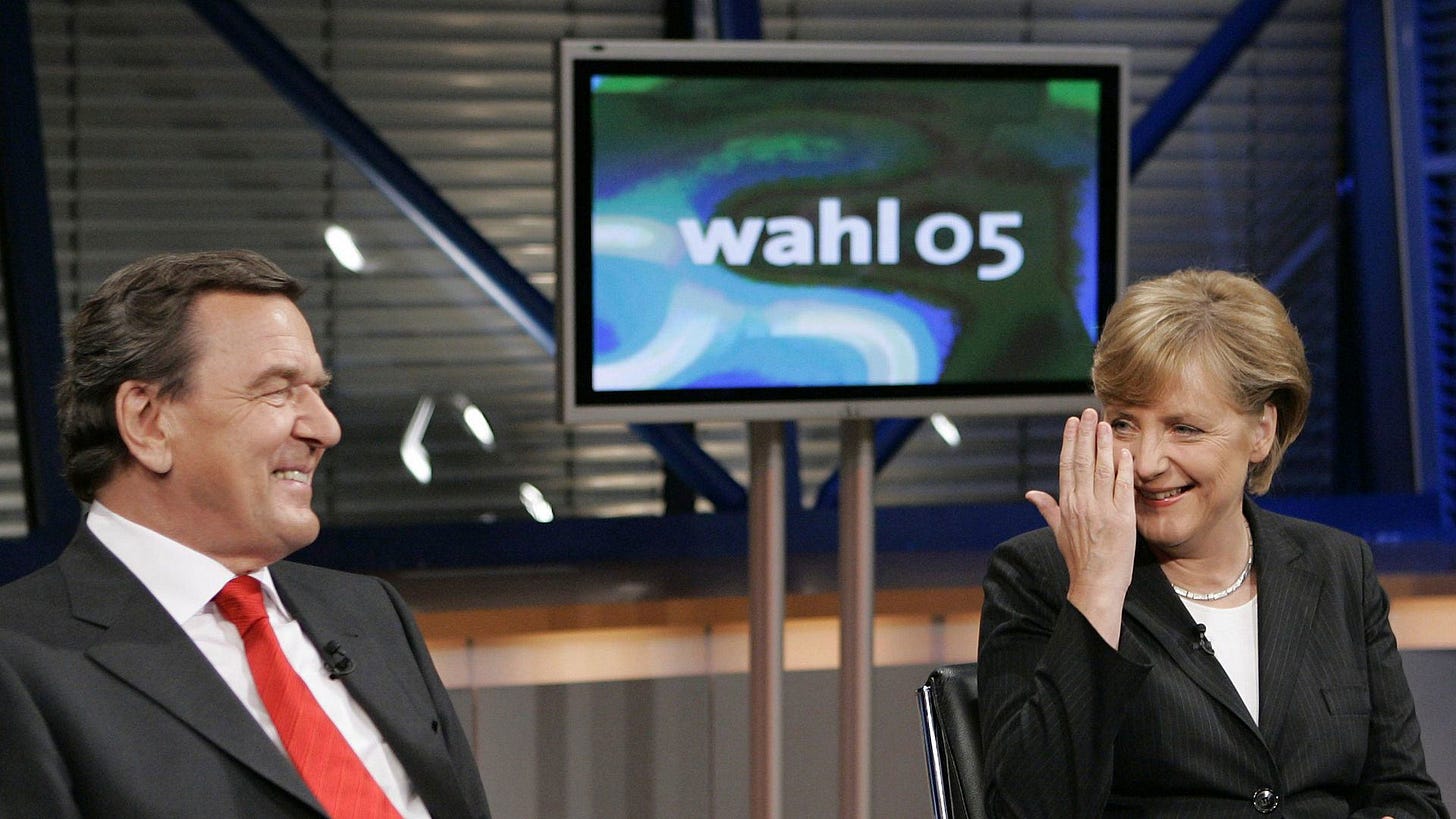The history of the political conflict in Germany (Part II)
The ongoing history of the politics of the Federal Republic
Part I: A look at the political history of the Federal Republic
After looking at the development of the two large “Volksparteien” as well as the smaller party of the FDP, we now enter a new era in the history of politics in the Federal Republic. We left off just as the first “Sozial-Liberale” (Social-Liberal) coalition was formed, with the former mayor of West Berlin, Willy Brandt, becoming the first Social Democratic Chancellor of the postwar era, his alliance with the Liberals of the Free Democrats holding strong despite being placed under severe strain due to the backlash to the Chancellor’s foreign policy pivot.
The rise of the Greens and the resurgence of the CDU
But the alliance would eventually break, and the same events which contributed to the end of the coalition would also provide a form of impetus for the development of a new party. Helmut Schmidt, who had followed Brandt as Chancellor, would be unable to reconcile his own party with the NATO dual-track decision. The FDP would eventually decide to abandon the SPD and ally once more with the party it had abandoned before: the CDU, now led by Helmut Kohl, who would go on to become the longest-serving chancellor in the history of the Federal Republic. But the controversy over the deployment of Pershing missiles would also provide fuel for the rise of another party. The Greens would develop out of the ’68 and growing ecological movement. Entering the Bundestag in 1983, the Greens would establish a new party of the left, one more focused on academics and activists, compared with the working-class-based electorate of the SPD. This would change the political makeup of the Federal Republic. If before the two Volksparteien had occupied the two sides of the political spectrum, with the FDP having the position as the middlemen, now four parties existed, with the CDU and FDP largely serving the right and the SPD and Greens occupying the left. This constellation would continue throughout the 1980s and through reunification, with the center-right coalition dominating the political scene until 1998. That year, for the first time in the history of the Federal Republic, a federal election would result in a government completely made up of parties not members of the previous coalition, with the CDU-FDP coalition being replaced by a new red-green dyad. And once more, the factor which had ultimately brought down the government would lead to the establishment of a new party: the persistent high unemployment, especially pronounced in the “New Länder,” the provinces of Germany which had just joined the New Republic. The same voters who had once thrown eggs at Helmut Kohl as he toured the former GDR would form the basis for the Left Party.
The Left, the cordon sanitaire, and the end of the Volksparteien
The Left, founded in large part by former members of the SED, rose to power trying to channel the interests of the left-behind voters in the East by returning to a truer and more undiluted form of left politics. They had ample material to support their hypothesis during the period of red-green governance that followed. In 2003, Gerhard Schröder introduced Agenda 2010, a series of labour market reforms intended to drive down the high rates of unemployment which, at this point, had become a constant feature of economic life. This would lead to conflict with many labour unions, who had previously made up the social base of the Social Democratic Party. The next years would see the slow but gradual erosion of the once-powerful Volksparteien, with the SPD seeing its fortunes flag prior to the CDU.
In 2009, the FDP, Greens, and Left would all see double-digit results, with both of the former Volksparteien managing results in the mid-20s and 30s, the only exception being 2017, which saw the CDU reach 41% at the height of Angela Merkel’s popularity. What was also notable is that the SPD pledged not to enter into a coalition with the Left, the party being seen as beyond the pale given its ties to the former SED (quite an ironic reason given that the CDU counted among its members and chancellors multiple former Nazis). While these events would hurt the SPD first, rendering it uncompetitive with the CDU led by Angela Merkel, who would govern for 16 years as the head of various coalitions, they would eventually go on to hurt the CDU itself.
The rise of the AFD and the end of stability
In 2013, the CDU had been dominant, achieving the best result for any party since the fall of the Berlin Wall, but four years later, trouble would show on the horizon. Originally founded to oppose various Eurozone bailouts, the AfD (Alternative für Deutschland) would find a new issue when Germany became the home of a wave of asylum seekers. This created a strong wave of resentment in the former East. Due to the strong focus on migration and asylum, the Left—originally the voice of the downtrodden in the East—was unable to capitalise on it. This allowed the AfD a rocket-like ascent, getting 12% of the vote in the 2017 federal election.
This marked a seismic shift in the workings of the Federal Republic. If left parties other than the SPD had existed since the 1980s, a party to the right of the CDU was something unheard of since the earliest days of the Republic. Unlike other right-wing parties which have no issue presenting themselves as actually right-wing, the CDU has always understood itself as occupying “the center” (Die Mitte), but during the Merkel era, this had taken on its apotheosis. This left space for the AfD to outflank the CDU and establish itself as a permanent fixture of the politics of the Federal Republic.
It also meant that the Bundestag now included two parties deemed by the mainstream to warrant a cordon sanitaire, making the forming of coalitions increasingly difficult. Outside of a grand coalition, the only feasible solution was a three-way constellation, as occurred after the 2021 federal election. But this would only produce further instability, with the traffic-light coalition being widely derided and making none of its participants truly happy.
By 2025, the complete shift of the electoral system had become well and truly apparent, the SPD, led by the unpopular Chancellor Olaf Scholz, coming in third. This marked the first time in the history of the Federal Republic that a party other than the CDU or SPD had come in second. It also marked the first time that either of them had received less than 20% of the vote, with the SPD receiving a truly dismal 16%.
But increasingly, the “established parties” were seen as one and the same. In the eyes of the discontented, there is barely any difference between any of the parties which had a hand in governing the country; they had turned into one indistinguishable mush. As such, the parties which had been shut out of governance by the “Brandmauer” (cordon sanitaire) would actually benefit from this. (If the AfD and Left had received roughly 15% of the vote combined in 2021, this would increase to 28% by 2025.)
This inside–outside divide would also take on a strong regional dimension. The “Neue Länder” would be monopolised by the AfD; the fact that this party nevertheless remains shut out from power only fuels the sense of resentment that its voters feel. Originally, this development had primarily hurt the Left, traditionally the party dominating the region. The rise of the AfD at first seemed to mark the death knell of the Left. In 2021, it had received 4.9% of the vote and was only able to enter the Bundestag on a rare technicality which allowed it to subvert the 5% threshold (I won’t bore you with the details).
2025 was thought to mark the total end of the party, especially after one of its most famous MPs, Sarah Wagenknecht, left the party to found her own organisation, the BSW (“Bündnis Sarah Wagenknecht”—ever humble, she named the party after herself). Trying to steal the East from under the nose of the AfD with a campaign based around opposing weapons deliveries to Ukraine and the ideological concept of “conservative leftism” (??), she instead completely failed in her undertaking, inadvertently helping her former party, which would finally be able to win over the “urban proletariat” in the West of the country.
As it stands, the electorate is divided in five: the largest party still being the CDU/CSU, which dominates traditional economic elites and conservative voters in the West; the AfD, which has gone on to monopolise the East; the SPD, increasingly only appealing to older blue-collar workers who are turning or have already turned into pensioners; the Greens, appealing to academics; and the Left, serving the economic underclasses in the West.
The divides of Germany today are similar to those faced by other countries of the West, but the ghosts of the German past make them seem even more essential. Whether Germany will follow the United States in embracing nationalist populism is unclear—though it seems to be getting ever more likely by the day—but what is clear is that the certainty which defined the Federal Republic since its inception, and which seemed to have banished said ghosts, is no longer present.






